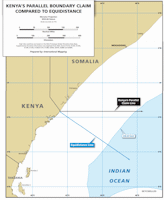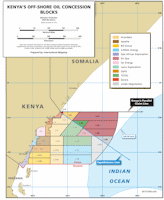Maritime Delimitation in the Indian Ocean (Somalia v. Kenya)
Public hearings in the case concerning Maritime Delimitation in the Indian Ocean (Somalia v. Kenya) concluded 18 March 2021 at the Peace Palace in The Hague, the seat of the Court. The Court will now begin its deliberation. Oral arguments were presented by the Federal Republic of Somalia on 15 and 16 March 2021. The Republic of Kenya did not participate in the hearings.
Marine fisheries have long been important to Somalia’s economy and culture. Somalia’s waters are rich in valuable, large pelagic species that are in demand around the world, including tuna. Historically, Somalia has sought to take advantage of these natural resources by developing its fisheries sector, especially its small-scale and artisanal fishing cooperatives. Distant Water Fleets from all over the world have been attracted to these resources and have operated in Somalia’s EEZ, frequently without licence. The value of the illegal, deepwater fishing hauls off Somalia, in 2005 alone (the last year for which data is available), was estimated at US$ 300 million, which would have equated to over 5% of Somalia’s GDP that year. Lobster is an especially important resource for Somalia and has become one of the country’s biggest exports.
Somalia has also recently taken steps to begin exploring its potential for both onshore and offshore petroleum exploration and production. While work was suspended following the start of Somalia’s civil war in 1991, the possibilities for such exploration are gaining steam now that the country is on the road to recovery and the security situation has improved. The hydrocarbon sector in Kenya is growing. Onshore oil concessions have been licensed since 1950 and offshore drilling has occurred since the 1970s. According to publicly-available information, Kenya began offering offshore petroleum exploration and exploitation blocks in the 1970s. Until at least 1996, none of these blocks extended beyond the equidistance line with Somalia.
Starting in or around 2000, Kenya changed tack and began acting on the basis of its unilateral parallel boundary claim to explore for and exploit the resources across the equidistance line in areas south of the parallel. In particular, Kenya has since then offered a number of offshore petroleum blocks for deep-water exploration and drilling, which extend to the parallel boundary it claims.
On 28 August 2014 the Federal Republic of Somalia instituted proceedings against the Republic of Kenya before the International Court of Justice (ICJ), the principal judicial organ of the United Nations, with regard to “a dispute concerning maritime delimitation in the Indian Ocean”. The International Court of Justice (ICJ) is the principal judicial organ of the United Nations. It was established by the United Nations Charter in June 1945 and began its activities in April 1946. The Court is composed of 15 judges elected for a nine-year term by the General Assembly and the Security Council of the United Nations. The seat of the Court is at the Peace Palace in The Hague (Netherlands).
Somalia contended that both States “disagree about the location of the maritime boundary in the area where their maritime entitlements overlap”, and asserts that “[d]iplomatic negotiations, in which their respective views have been fully exchanged, have failed to resolve this disagreement”. Somalia requested the Court “to determine, on the basis of international law, the complete course of the single maritime boundary dividing all the maritime areas appertaining to Somalia and to Kenya in the Indian Ocean, including the continental shelf beyond 200 [nautical miles]”. The Applicant further asks the Court “to determine the precise geographical co-ordinates of the single maritime boundary in the Indian Ocean”.
In the view of Somlia, the maritime boundary between the Parties in the territorial sea, exclusive economic zone (EEZ) and continental shelf should be established in accordance with, respectively, Articles 15, 74 and 83 of the United Nations Convention on the Law of the Sea (UNCLOS). Somalia explains that, accordingly, the boundary line in the territorial sea “should be a median line as specified in Article 15, since there are no special circumstances that would justify departure from such a line” and that, in the EEZ and continental shelf, the boundary “should be established according to the three-step process the Court has consistently employed in its application of Articles 74 and 83”.
Kenya’s position on the maritime boundary is that it should be a straight line emanating from the Parties’ land boundary terminus, and extending due east along the parallel of latitude on which the land boundary terminus sits, through the full extent of the territorial sea, EEZ and continental shelf, including the continental shelf beyond 200 nautical miles. Kenya has, moreover, purported to grant commercial oil concessions in the areas located between its parallel boundary claim and the equidistance line claimed by Somalia. Kenya freely negotiated a parallel boundary with Tanzania and voluntarily undertook to be bound by that maritime border. Kenya sought to justify the parallel line by appeal to “equitable principles”, claiming that an equidistant boundary would be inequitable in light of the maritime boundary that Kenya negotiated with its southern neighbour, Tanzania, in 1976 and 2009.
Kenya’s 1972 Territorial Waters Act and 1989 Maritime Zones Act expressly provides for an equidistant delimitation of the territorial sea, while also providing that the EEZ boundary “shall be delimited … pursuant to an agreement between Kenya and Somalia on the basis of international law”. Despite these provisions, in 1979 and then again in 2005 the President of Kenya made unilateral proclamations laying claim to a parallel boundary in both the territorial sea and the EEZ. Consistent with these Presidential Proclamations, Kenya has offered a number of petroleum blocks for deep-water exploration and drilling in areas across the equidistance line that extend up to the claimed parallel boundary.
Somalia considers Kenya’s claim to be inconsistent with international law. A boundary along a line of parallel has no basis the Convention and cannot be justified by reference to any aspect of the history, geography or relevant practice of either Party. As one of the world’s poorest countries, Somalia’s maritime resources are particularly valuable natural assets as these resources assume increasing importance for Somalia’s future development.
The geography of the Somali and Kenyan coastlines are unremarkable, having a straightforward and stable configuration. The Parties’ coasts abutting the area to be delimited are straight and smooth. There are no significant recesses, protuberances or other formations that might affect the delimitation process. Unlike many other disputed maritime boundaries, the Court is not called upon here to consider the effects of any complex or anomalous coastal features, or to modify established principles of maritime delimitation to take account of unstable land formations. The delimitation exercise is straightforward. The Parties have never concluded any agreement, written or otherwise, concerning the delimitation of their maritime boundary. Both are bound by the Convention and have emphasised their commitment to honouring its provisions, including in relation to the delimitation of their maritime boundaries.
Kenya decided not to participate at the Maritime Delimitation Case (Somalia v Kenya) at the International Court of Justice. "This decision is on account of procedural unfairness at the Court.... Kenya outlined that while it had no doubt about the merits of its case, procedural unfairness had left doubt on whether substantive justice would be done. Kenya re-stated that it should not have been dragged to the Court by Somalia merely because of the neighbor’s resurgent expansionist agenda. Kenya also noted that the composition of the membership of the bench conducting the case reinforced concerns of bias, citing the case of Somali Citizen, Judge Abdulqawi Yusuf, who sits on the ICJ and who has previously represented Somalia at the Third United Nations Conference on the law of the sea. At the conference the Judge stated that delimitation of the EEEZ and continental shelf should not be effected in accordance to the principle of equidistance but rather by application of equitable principles....
"Kenya has also informed the Court that influential third party commercial interests are fueling the case, that threatens to destabilize the peace and security of an already fragile region. The speed at which the matter was rushed before the Court and the players involved in this dispute, pointed to a well-orchestrated strategy of pitting the countries against each other in total disregard to the precarious security situation in the region. Influential third parties are intent on using instability in Somalia to advance predatory commercial interests with little regard to peace and security in the region."
|
NEWSLETTER
|
| Join the GlobalSecurity.org mailing list |
|
|
|



